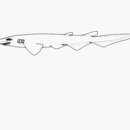Diagnostic Description
provided by Fishbase
Relatively slender, moderately long, narrow snout and relatively narrow, low caudal fin. Color uniform dark brown (Ref. 37039). First to third gill openings long as the distance between the nostrils (Ref. 6032).
- Recorder
- Arlene G. Sampang-Reyes
Life Cycle
provided by Fishbase
Oviparous, paired eggs are laid. Embryos feed solely on yolk (Ref. 50449). Sexual dimorphism is evident in dentition of males (Ref. 49562). Males have longer teeth with fewer cusps (Ref. 51093) to make 'courtship biting' more effective (Ref. 49562).
Biology
provided by Fishbase
Found on the continental slopes. Oviparous, with one egg per oviduct laid at a time. Sexual dimorphism in adults unusually well-developed.
- Recorder
- Kent E. Carpenter
Importance
provided by Fishbase
fisheries: of no interest
- Recorder
- Kent E. Carpenter
Broadgill catshark
provided by wikipedia EN
- license
- cc-by-sa-3.0
- copyright
- Wikipedia authors and editors
Broadgill catshark: Brief Summary
provided by wikipedia EN
The broadgill catshark (Apristurus riveri) is a catshark of the family Scyliorhinidae, found in the Gulf of Mexico and the Caribbean Sea, between 30°N and 9° N, on the continental slopes at depths between 700 and 1,500 m. Its length is up to 46 cm. The reproduction of the broadgill catshark is oviparous.
- license
- cc-by-sa-3.0
- copyright
- Wikipedia authors and editors
Distribution
provided by World Register of Marine Species
Cuba, northern Gulf of Mexico, and Panama
North-West Atlantic Ocean species (NWARMS)
- license
- cc-by-4.0
- copyright
- WoRMS Editorial Board
Habitat
provided by World Register of Marine Species
Found at depths of 860 - 1098m.
North-West Atlantic Ocean species (NWARMS)
- license
- cc-by-4.0
- copyright
- WoRMS Editorial Board
Habitat
provided by World Register of Marine Species
benthic
North-West Atlantic Ocean species (NWARMS)
- license
- cc-by-4.0
- copyright
- WoRMS Editorial Board

